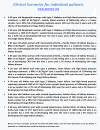Predicting the risk of chronic Kidney Disease in men and women in England and Wales: prospective derivation and external validation of the QKidney Scores
- PMID: 20565929
- PMCID: PMC2905345
- DOI: 10.1186/1471-2296-11-49
Predicting the risk of chronic Kidney Disease in men and women in England and Wales: prospective derivation and external validation of the QKidney Scores
Abstract
Background: Chronic Kidney Disease is a major cause of morbidity and interventions now exist which can reduce risk. We sought to develop and validate two new risk algorithms (the QKidney Scores) for estimating (a) the individual 5 year risk of moderate-severe CKD and (b) the individual 5 year risk of developing End Stage Kidney Failure in a primary care population.
Methods: We conducted a prospective open cohort study using data from 368 QResearch general practices to develop the scores. We validated the scores using two separate sets of practices--188 separate QResearch practices and 364 practices contributing to the THIN database.We studied 775,091 women and 799,658 men aged 35-74 years in the QResearch derivation cohort, who contributed 4,068,643 and 4,121,926 person-years of observation respectively.We had two main outcomes (a) moderate-severe CKD (defined as the first evidence of CKD based on the earliest of any of the following: kidney transplant; kidney dialysis; diagnosis of nephropathy; persistent proteinuria; or glomerular filtration rate of < 45 mL/min) and (b) End Stage Kidney Failure.We derived separate risk equations for men and women. We calculated measures of calibration and discrimination using the two separate validation cohorts.
Results: Our final model for moderate-severe CKD included: age, ethnicity, deprivation, smoking, BMI, systolic blood pressure, diabetes, rheumatoid arthritis, cardiovascular disease, treated hypertension, congestive cardiac failure; peripheral vascular disease, NSAID use and family history of kidney disease. In addition, it included SLE and kidney stones in women. The final model for End Stage Kidney Failure was similar except it did not include NSAID use.Each risk prediction algorithms performed well across all measures in both validation cohorts. For the THIN cohort, the model to predict moderate-severe CKD explained 56.38% of the total variation in women and 57.49% for men. The D statistic values were high with values of 2.33 for women and 2.38 for men. The ROC statistic was 0.875 for women and 0.876 for men.
Conclusions: These new algorithms have the potential to identify high risk patients who might benefit from more detailed assessment, closer monitoring or interventions to reduce their risk.
Figures



References
-
- Rahman M, Pressel S, Davis BR, Nwachuku C, Wright JT Jr, Whelton PK, Barzilay J, Batuman V, Eckfeldt JH, Farber MA. Cardiovascular outcomes in high-risk hypertensive patients stratified by baseline glomerular filtration rate. Ann Intern Med. 2006;144(3):172–180. - PubMed
-
- Drey N, Roderick P, Mullee M, Rogerson M. A population-based study of the incidence and outcomes of diagnosed chronic kidney disease. American journal of kidney diseases: the official journal of the National Kidney Foundation. 2003;42(4):677–684. - PubMed
Publication types
MeSH terms
LinkOut - more resources
Full Text Sources
Medical

